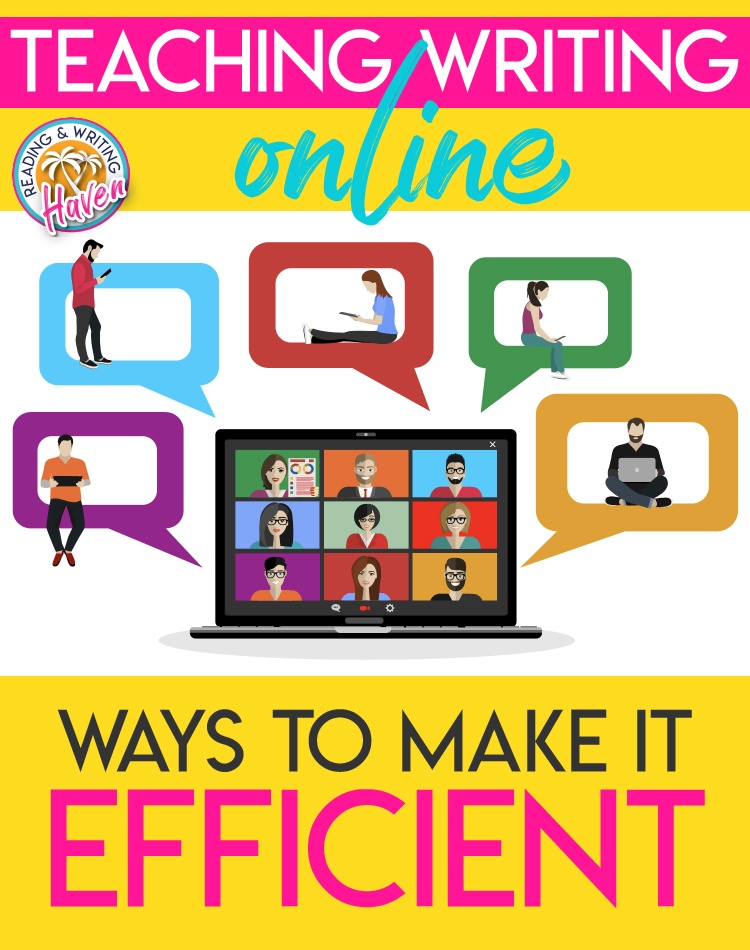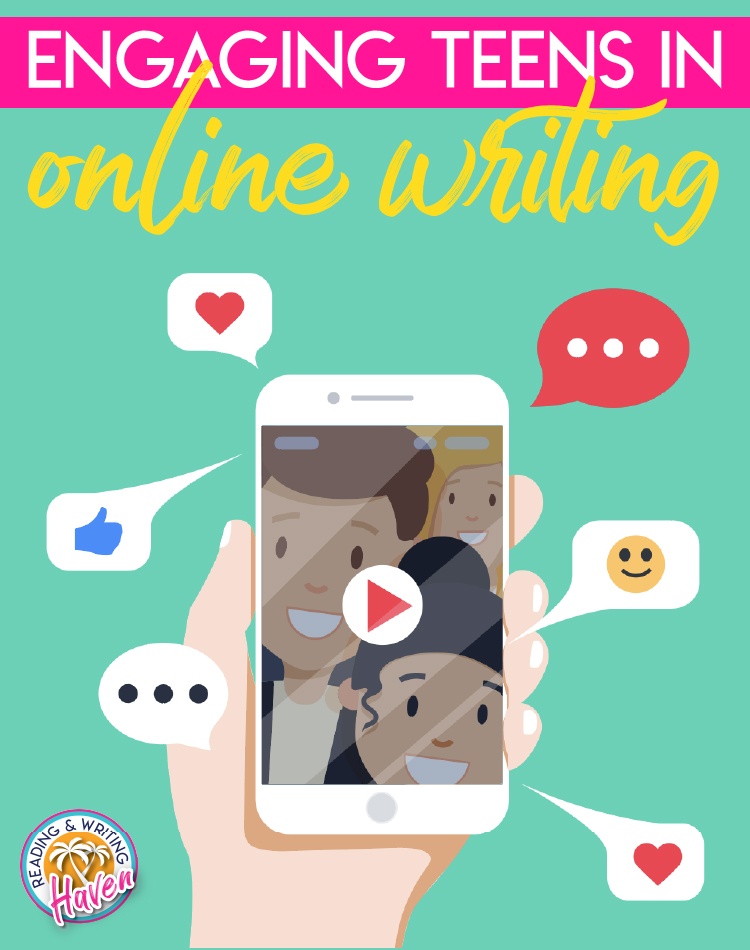Simple Ways to Make Teaching Writing Online More Effective
Inside: Teaching writing online is challenging. This post outlines simple strategies to make it more efficient, effective, and engaging.
Overwhelming. That’s the first thought that comes to mind when I think about teaching writing online. When it comes to grading essays, I’m sure we can all relate to a secret desire to hide them all and pretend they don’t exist. Certainly, it’s easier to do this digitally than when stacks of essays loom over our desks like skyscrapers. There’s a reason these essays cause us so much stress: They threaten to consume every second of our free time!
Perhaps you’re searching for ways to…
- make feedback efficient?
- make online writing lessons more effective?
- engage secondary writers virtually?
Yes, yes, and yes! But, how? We can’t let digital writing instruction steal our sanity…or our lives. For each challenge, we can find some solutions. This post includes ideas that can work for blended learning, hybrid situations, and distance learning. Of course, there’s plenty of application to in-person writing instruction as well.
CHALLENGE #1: EFFICIENCY
Priority number one with teaching writing online is making sure it doesn’t take over our lives. Providing feedback in person is, in itself, time consuming. Add the element of distance, and the convenience of quick face-to-face conversations is gone.
Efficient Solutions
1. Narrow the skill focus.
Often, my rubrics have six to seven categories when I assess essays. I look at things like word choice, sentence fluency, organization, ideas, citations, and voice. Managing all of this feedback virtually may not be realistic. So, we can think about what really matters most.
Depending on the type of writing students are producing, we might be able to focus on fewer categories. Perhaps their introduction and conclusion paragraphs are the points of emphasis, for example. We can also differentiate our feedback by including all categories on a rubric but telling students they will only receive detailed feedback about two points on the rubric: an area of strength and one for growth.
For example, these Spooky Story Starters are fun for Halloween and allow you to select just one skill to focus on with feedback.
2. Record your feedback.
Talking is both more personal and more efficient than writing. If you can find a simple way to verbalize your feedback for students, it might save you some time. You can record an mp4 file or video. The website Vocaroo is an amazing tool that allows you to record audio files and share them with students via a QR code or mp3 file. And, your learning management system may have audio features as well. For example, Schoology has a built-in audio and video recording tool. Audio and video feedback can be less overwhelming to provide and feel more like writing conferences for students.
3. Involve students.
Students learn by being part of the reflective process. Ask students to own their learning by building in some metacognitive work. They can…
- ask pointed questions (What are they really wanting feedback about with their writing?)
- self evaluate with built-in student rubrics and Google Forms (specifically, reflect on the learning targets)
- help to create the assignment rubric during a virtual class meeting (this practice increases buy-in and awareness)
4. Look for trends.
Efficiency means categorizing, in some cases. Before providing feedback, skim through students’ essays for common issues. For example, the informal use of “you,” run-on sentences, or periods before MLA in-text citations. Then, provide re-teaching mini lessons based on those needs. When our mini lessons are purposefully targeted as a response to students’ current needs, older students are more likely to make the necessary revisions.
And, creating comment banks is a strategy we can use to quickly provide the same type of feedback across multiple students. “Please review your essay for incomplete sentences.” Just copy and paste. You an even add a link to a video mini lesson or reference page that reinforces the corrections students need to make.
CHALLENGE #2: EFFECTIVENSS
Let’s be real. Teaching writing online (actually, teaching pretty much anything online) is exhausting. Since we are going to be exerting energy to create lessons, we definitely want to maximize the effectiveness of those lessons. How can we work smarter to preserve our mental health?
Effective Solutions
1. Think aloud during mini lessons.
When teaching writing online, keep lessons short. I try to keep my mini lessons under fifteen minutes. Targeting a particular skill or standard helps me to be concise while also modeling for students. In the physical classroom, I provide more context around ingredients for each paragraph in an essay. But online, I fold that conversation into my modeling to save time.
For instance, I use the acronym ABC for introduction paragraphs. In person, I like to introduce each letter, study good and bad examples, and practice writing different hooks and background sentences. Online mini lessons need to be concise, so keep it simple. Tell them what you are doing as you write and why you are doing it.
Example: As a writer, my internal dialogue sounds like this: I want to begin by writing, “Did you know that sea turtles can live 100 years?” But…that’s predictable, and not very surprising. I’m not sure if it would grab anyone’s attention. So, what else could I try? I remember Mr. H. introduced three ways to hook the audience. Maybe I should try using figurative language here…a simile, maybe? Let’s see..Sea turtles are like the oldest, most comfortable pair of jeans in a closet. They have longevity and are full of scars that hint at a life of adventure. I like that better. I don’t love it, but that’s good for a rough draft. I’ll come back to it later!
If students need more direction, we can always offer virtual office hours to re-teach or conference.
2. Record videos.
Videos can be life savers because you can use them in person, remotely, and for absent students or those who need to hear the lesson more than once. They don’t have to be polished, and they don’t have to be time consuming to make.
Suggestion: If you choose to share your videos to YouTube, consider making them Unlisted so that only your students can access…that way, you can legally use high-interest mentor texts and story excerpts to show them how authors use these writing skills in their published works.
Here are some options for dependable ways to make videos:
- Screencastify
- Loom
- FlipGrid
- QuickTime
You can also record your online Google Meet or Zoom session and share the link! Looking to make videos that are more polished? Try…
- Explain Everything
- Apple Clips
- iTunes
- PowToon
To be efficient with video creating, consider making a document all of the ELA teachers in your grade level can access. Work together to cover topics you know you’ll all be teaching (thesis statements, transitions, etc.), and split the workload. Some teachers choose to show a video created by another teacher (to save time) and then follow up with their own activities and examples.
Some of my current writing lessons and units (listed below) contain instructional videos that include modeling, thinking aloud, and direct instruction.
- Avoiding Plagiarism
- Writing Process Refresher
- Descriptive Writing
- Photo Essay (Informative Writing)
- Digital One Pagers
3. Chunk the learning.
One lesson we all learned online in Spring 2020 is that everything taught online needs to be chunked. It’s just so hard for students to stay focused on lengthy lessons with multiple steps virtually. (Understandably so since we have no idea what their learning environment is like, and they have other classes to attend each day.)
Chunking Time: Many schools have switched to a block schedule with 90 minute class periods for eLearning. Why not have students meet synchronously for a quick mini lesson (or ask them to watch the video you have created), then give them time to work on writing, and finally pop into a synchronous or virtual office hours session to confer about their writing?
Chunking Content: Rather than giving students the task of writing an entire essay in one sitting, we can chunk those tasks for them. Perhaps…
- Thesis
- Topic Sentences
- Introduction Paragraph
- Citations of Research
- Body Paragraphs
- Transitions
- Conclusion
- Formatting
Then, add in additional mini lessons based upon specific student needs as you see them complete each part of the essay. And, of course, each of the topics mentioned above can be further divided into smaller parts, depending on students’ readiness levels.
4. Anticipate misconceptions.
We can be more effective when teaching writing online if we anticipate misconceptions. It is challenging to do that when students aren’t right in front of us. A few strategies that might help…
Create an opportunity for students to follow up a lesson before writing by asking questions. What are they confused about? This can be done in a variety of formats: Google Forms, on a Google Slide or Doc, on a class Padlet or Flipgrid, or as a discussion thread on your Learning Management System.
When teaching synchronously, have students hold up red, yellow, or green pieces of paper to indicate understanding. You can also have students use emojis or check marks and Xs. These are quick, visual formative assessments.
If you’ve taught prior to this year, you also have the background knowledge of previous students’ misconceptions that you can bring into your virtual lessons. For instance, when teaching students how to write an introduction paragraph, many of them find it challenging to build background and context for readers. So, it’s necessary to scaffold, showing them specific strategies they can use to add meaningful context to their introduction paragraphs to orient readers.
CHALLENGE #3: ENGAGEMENT
Even if we come up with ways teaching writing online can be efficient (in terms of time) and effective (in regards to lesson planning), we still need that third ingredient — engagement. Of the three, this one is the most dependent upon our students. Understanding that it may not be possible to engage every single student online (it’s okay to give ourselves some grace here!), we can still do everything in our power to provide an engaging writing opportunity for them.
Engaging Solutions
1. Build in interest.
As in the physical classroom, we need to build in opportunities for students to be interested in the writing activity. We can…
- Give students the option to choose a topic.
- Allow them to choose a mode of writing within a larger writing genre.
A writing survey can help us to get to know our writers so that we can figure out how to engage them better.
2. Incorporate relevance.
Students will, naturally, be more engaged and interested in writing when they understand its relevance. That doesn’t mean we shouldn’t ask them to write essays, but it does mean we might need to hook them with other writing assignments first.
For example, email etiquette is always my first writing lesson of the year. Students see the immediate relevance because they use it every day. And, they understand the implications for not writing eloquent emails. (typically, not receiving a response or receiving and email asking them to re-type their first email to demonstrate email etiquette skills)
Similarly, when teaching students to avoid plagiarism, we can incorporate recent, real-world examples to drive home the relevance factor. Yes, plagiarism has consequences – even outside of school!
And, social media is ubiquitous. I love using it in my lesson plans. We can teach use social media in writing activities to…
- have students use vocabulary in context
- explore poetry’s use in modern texting conversations
- create a “snap” (reflection / literary element analysis) of reading
3. Use authentic audiences.
Whenever possible, teaching writing online is more engaging with an authentic audience. We can ask students to…
- write to a politician advocating for change
- tag an author in a social media post about their book(s)
- send a letter to a friend or family member
- create a blog, infographic, Adobe Spark Page, or Google Site
And, we shouldn’t be afraid to let students choose their authentic audience. We can define the criteria for writing and allow them to pick the avenue that sounds most meaningful to them. During an online classroom meeting, we can host publishing parties and celebrate the audiences with which students share their finished compositions.
4. Make it visual.
Everything is better with visuals. Think about the books reluctant readers enjoy. Typically, ones with pictures! People are naturally drawn to colors and patterns. One way to engage writers online is to unexpectedly add visual elements to writing. Think about some of these possibilities:
- color-code parts of paragraphs
- highlight research
- add special formatting (headings, pulled-out quotes)
- incorporate graphs, charts, and drawings
One of my favorite new writing units is an academic photo essay. It’s not the same as one you might see in photojournalism, but that’s what inspired the idea for my academic photo essay. Students still practice skills aligned with all the informative writing standards, but they also combine photographs. Pictures add an emotional layer to writing, and the photo essay is a refreshing twist on traditional essays. Visuals can make a big difference with engagement.
Teaching writing online can be daunting. But, we can implement some simple strategies to increase efficiency, effectiveness, and engagement. I hope you’ve found some new ideas that will make your teaching load more manageable this year. We cannot let teaching writing online be the death of our passion for our profession. Getting together with English teaching friends both online and in person to brainstorm solutions is powerful. What is working for others? How can we work together to lessen the load? Creative solutions can give us the sanity we need.
READ NEXT:
- 10 Tips for Avoiding Burnout with Distance Learning
- How to Make the Most of eLearning Days
- Easy Ways to Organize Online Learning
- Digital Skills for Online Learning
- Digital One Pagers: How To



